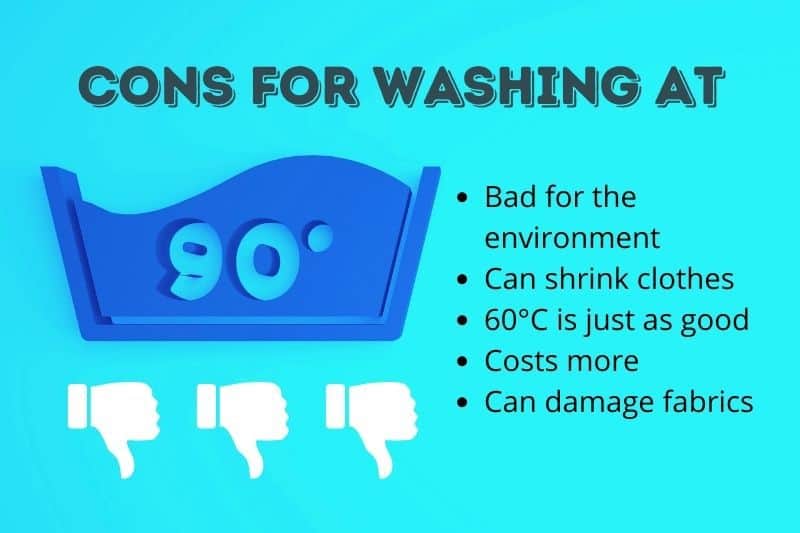If you think your clothes need to be deep cleaned on a nice hot wash, you might be tempted to switch your washing machine to the 90-degree temperature setting.
But, is washing at such a high temperature a good idea? It’s not essential to wash clothes or any household items at a 90°C setting. You can easily wash your items at a lower temperature and by using a specialised detergent. This also helps to promote a greener way of life too.
However, there are times when a 90-degree wash can be very handy.
I’ve put together a list of ‘for and againsts’ for you to read through before you start washing at 90 degrees. Check out the lists below.

Reasons For Washing at 90
1. A 90-degree wash can be used to clean your washing machine
You should aim to clean your washing machine every 3 months as this will help to remove any nasty bacteria that’s been setting up home inside. Plus, it gets rid of any smells that have built up.
Before you start cleaning your washing machine, make sure that there are no clothes inside the machine. Then, select the hottest temperature, in this case, 90°C. Add some bio powder into the detergent draw and start the wash. This general clean will help to keep your washing machine running smoothly!
2. A temperature of 90 degrees can remove stubborn stains on cotton clothes
If you’ve got a particularly horrible stain on a cotton item of clothing you can use this temperature, along with an appropriate detergent, to remove the stain. You should try and wash the item with similar colours as well.
You could also try to use a 60-degree wash to remove hardy stains.
3. A wash at 90 degrees can brighten whites
Keeping white clothes white can be a bit of a problem. But, if you combine a 90-degree wash with some biological powder, your clothes will be glowing in no time at all.
4. Good for keeping your towels, underwear and soiled cotton clean
It’s safe to say that some items of clothing and household goods are going to be covered in more bacteria than others. If you feel that a thorough clean is needed for these items a 90-degree wash should do the trick.
But remember to add an appropriate detergent and don’t forget that this type of wash could be done at 60 degrees too.
5. Works well with 100% cotton materials
Cotton is one of the only materials that can be successfully washed at this temperature. So, if you have a wardrobe full of 100% cotton clothes, you’re onto a winner.
But again, you probably don’t need to use such a high temperature because cotton can be washed at much lower temperatures.

Reasons Against Washing at 90
1. 60 degrees is just as good!
90 degrees is an extremely hot temperature, so it’s easy to assume that by using this temperature you’ll be able to rid yourself of any germs and stains that have built up on your clothes really quickly. However, according to Which? there’s no reason to believe that you have to wash clothes at 90 degrees to get rid of bacteria. A 60-degree wash with a strong detergent should do the job just as well.
Why? Simple, 60 degrees is hot enough to remove bacteria, as long as you have the correct detergent in tow. Plus, it’ll be slightly cheaper, greener and more efficient than 90 degrees.
2. A 90-degree temperature is not sufficient on its own
While hot water is good at killing off germs, it’s not going to do an amazing job on its own. What do I mean by this? Basically, the very hot water needs to be combined with a detergent that is designed to get rid of bacteria. The water and the detergent will work well together, and in the end, you will get bacteria-free clothes, but there may be an extra cost involved (buying the right detergent).
3. Clothes are likely to shrink on a 90-degree wash
Any boiling hot water is likely to shrink clothes, and because 90 degrees is one of the hottest temperatures, it’s almost certain that clothes will shrink in this type of wash. Is the risk really worth it? Probably not. Most clothes can’t be washed at such a high temperature, so read your clothing tags and stick to what they say. Don’t spoil all your clothes.
4. There’s a possibility that clothes may be damaged during a 90-degree wash
Like with the shrinking I mentioned above, a 90-degree wash could actually damage clothes too. Clothes that shouldn’t be washed at this temperature can become deformed, which may result in them no longer holding their shape. In the end, you’ll be less likely to wear a top, for example, that doesn’t look and feel how it’s supposed to.
5. Coloured clothes may change colour if you use a 90-degree temperature
Coloured clothes and hot water don’t always mix too well together. The end result is usually, clothes losing colour or colours running. Neither of these is very good and you could end up with ruined clothes.
Plus, as I’ve mentioned before, you could use a lower temperature to wash clothes anyway. According to Which, 30 degrees is a good temperature for coloured clothes, it’s also cheaper to run this cycle, it’s more energy efficient and it’s more environmentally friendly.
6. Not all materials can be washed at a 90 degrees temperature
I cannot stress enough how important it is before you do any sort of wash that you check your clothing tags. On your clothing tags, there are instructions that tell you how you can/cannot wash your items. It’s really important that you follow these instructions because if you don’t you’ll likely wreck your clothes, or you’ll make them unwearable.
You’ll rarely see ‘Safe to wash at 90 degrees’ on clothing tags because most clothes don’t need such a high temperature when being washed.
7. 90 degrees is a costly affair
Running a washing machine can be expensive, so the easiest way to cut your costs is to use a lower temperature. Think about it, to heat the water in your washing machine to 90 degrees takes a lot of power, and this power costs money. If you used a lower temperature, say around 30 degrees – 40 degrees, you wouldn’t need to spend so much time and energy heating up the water, so the cost of your wash would be a lot less.
However, if you feel that you need a higher temperature, then you should do what you think is right.
8. Environmental impact
Washing clothes in a washing machine increases your carbon footprint, which isn’t a good thing. A high wash like a 90 degree one is worse still, because it needs more energy, and this extra energy ends up putting more strain on the washing machine (which means the machine is slowly breaking down and parts will need to be repaired).
Lots of microscopic fibres also get released into the water systems around us when a washing machine is used, this ends up causing water pollution.
But, obviously, clothes and the likes need to be washed, so here are a few ways to reduce the impact of using a 90-degree wash temperature:
-
- Use a lower heat setting to save energy.
- Wear your clothes more than once, then wash them.
- Dry your clothes on the line after they’ve been washed, so no tumble drying.
- Use an air purifier in the washing machine room to help clear away the CO₂ and mould.
Everyday Cleaning
If you use your washing machine every single day, you’re better off using a 30°C – 40°C temperature. Assuming that your clothes are covered in ‘daily dirt’ and not hard stains. (You should treat hard stains and wash them accordingly).
A normal wash at these temperatures is enough to clean your clothes, it keeps running costs down, it keeps your clothing’s colours in place and the washing machine doesn’t use up so much energy.
Conclusion
There’s no need to wash clothes, towels and underwear at a 90-degree temperature. If you use an antibacterial detergent, as well as a 60-degree wash, your items will be thoroughly cleaned. Plus, most clothes are okay to be washed at 30 degrees or 40 degrees.
There are consequences to using a 90-degree temperature, namely this type of wash can ruin your clothing and it’s harmful to the environment.
However, if you feel that it is absolutely necessary to use a 90-degree temperature then you should do so at your own risk.
FAQs
I have mites, should I use a 90-degree wash to get rid of them?
A 60-degree wash with an antibacterial detergent should get rid of mites – no need to use the 90°C setting.
What temperature should denim jeans be washed at?
A temperature of 40 degrees or less is acceptable for denim jeans. But if you’ve got a ‘jeans’ setting on your washing machine, you’d be better off clicking that button and then washing your jeans on that setting. Don’t wash them at 90 degrees.

Bethan has a passion for exploring, reading, cooking and gardening! When she’s not creating culinary delights for her family, she’s concocting potions to keep her house clean!






